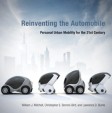 Reinventing the Automobile: Personal Urban Mobility for the 21st Century
Reinventing the Automobile: Personal Urban Mobility for the 21st Century
- William J. Mitchell,
- Christopher E. Borroni-Bird &
- Lawrence D. Burns
The sensation of the 1953 Turin Auto Show was a vehicle with an engine of just less than 10 horsepower. The Italian engineer and entrepreneur Renzo Rivolta had decided that his company, Iso, should design and produce a car adapted to the needs of post-war Europe. The Isetta — 'the little Iso' — was small and simple, had room for two passengers and was affordable.
Before long, licences to build the tiny car were sold to Belgium, France, Spain, Brazil and, most importantly perhaps, Germany, where the BMW Isetta was a sweeping success — more than 160,000 of BMW's version of the 'bubble car' were built between 1955 and 1962. The vehicle, together with other 'microcars' of the day, became a symbol of Europe's economic recovery after the war and of individual freedom regained. But with increasing prosperity, the microcars eventually disappeared from the streets, to be replaced by bigger, more powerful and more comfortable models.
The twenty-first century presents new transport challenges, different from those of post-war Europe, but no lesser. Reducing both pollution and our dependence on fossil fuels are high on today's political agenda. Our concept of personal transport — which has barely changed since the days of the Isetta — is on the verge of collapse, as witnessed by anyone who lives in an urban area (and today that is more than half of the Earth's population; by 2030 it could be 80%).
In Reinventing the Automobile, William Mitchell, Christopher Borroni-Bird and Lawrence Burns present their vision of how personal mobility might develop through this century. Their proposal is based on four 'big ideas': first, change the basic design of cars to electrically powered vehicles that interact wirelessly with each other and with roadway infrastructure; second, create a 'Mobility Internet' that allows cars to share real-time and location-specific information about traffic and road conditions; third, set up a 'smart' utility grid to supply the cars with electricity; and fourth, develop dynamical pricing systems for power, parking, and road and vehicle use.
None of these ideas are, in themselves, surprising. But the wealth of information compiled in Reinventing the Automobile makes the book an arresting read and a valuable resource. The breadth of the discussion — from different angles, with the support of many graphs, images and tables — leaves a deep impression of how we might get around in the future. The focus, however, is exclusively on urban mobility, as the subtitle of the book makes clear. The situation outside cities is untouched.
The big question, of course, will be whether it is possible to realize these ideas in practice. A broad awareness of the problems ahead is needed, but also genuine willingness to tackle them, not least through each of us evaluating our own needs and degree of flexibility. How much are we willing to change our routines? Just how big a car do we really need?
Rights and permissions
About this article
Cite this article
Trabesinger, A. Quo vadis, motor car?. Nature Phys 6, 237 (2010). https://doi.org/10.1038/nphys1647
Issue Date:
DOI: https://doi.org/10.1038/nphys1647

